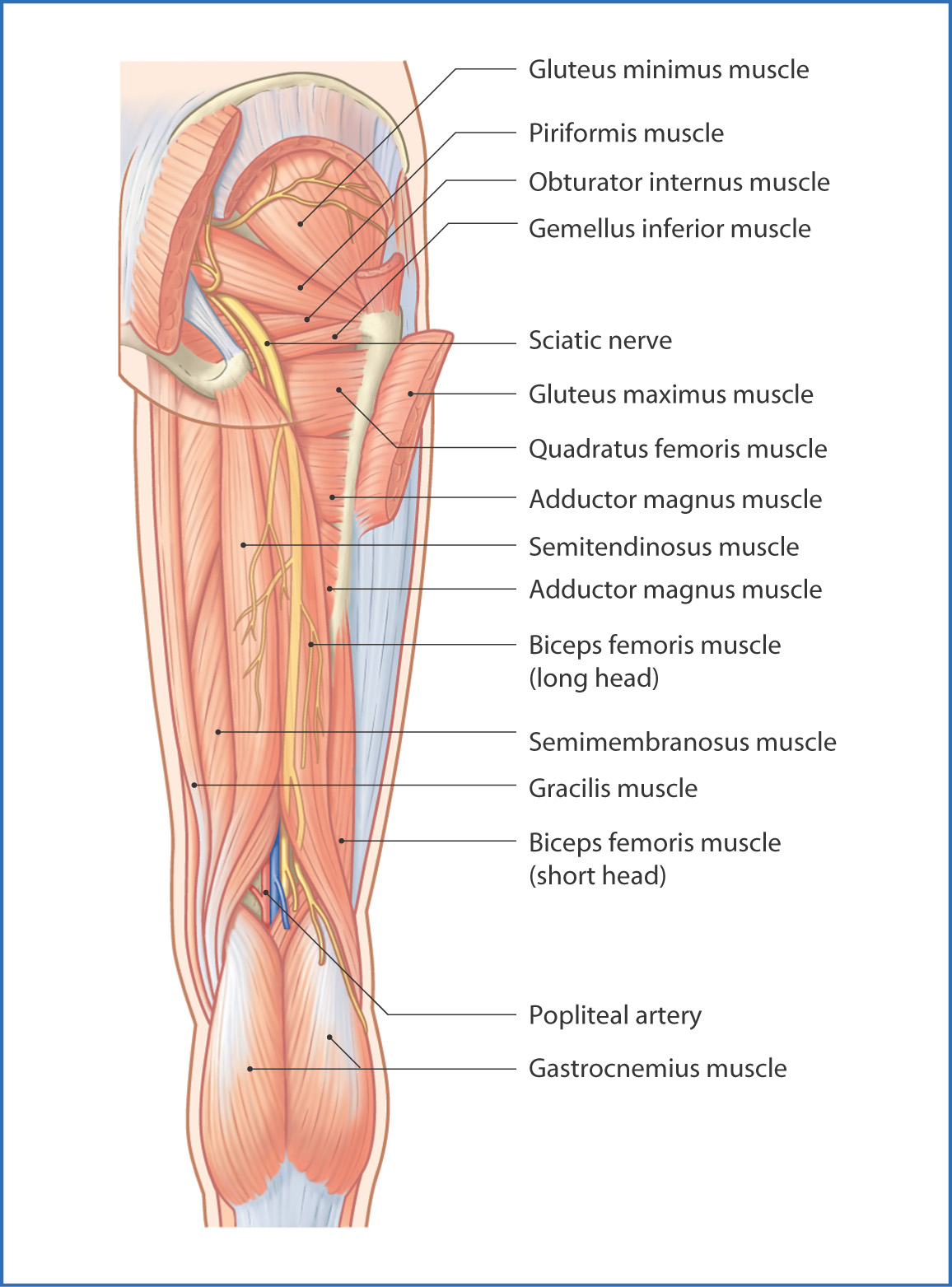
42
Gluteal Region and Posterior Thigh
The gluteal region (buttock) extends from the upper border of the posterior iliac crest to the inferior border of the gluteus maximus muscle. The posterior part of the thigh extends from the inferior edge of the gluteus maximus muscle down to the upper border of the popliteal fossa. Support for the gluteal region and posterior compartment of the thigh is from the pelvic girdle and femur. These bones provide attachment for the muscles and ligaments of the region. Enclosing the tissues of the gluteal and posterior thigh region are the gluteal aponeurosis and fascia lata. These heavy, thickened fasciae form an enveloping sleeve over the muscles of the gluteal region and thigh.
The parts of the pelvic girdle (hip bones, sacrum, and coccyx) are bound together by dense ligaments. The sacrotuberous and sacrospinous ligaments convert the sciatic notches of the hip bones into greater and lesser sciatic foramina (see Chapter 36).
Muscles
The muscles of the gluteal region (Fig. 42.1) include three large gluteal muscles and the deeper group of smaller muscles. The gluteus maximus is a large fan-like muscle and a strong extensor of the thigh that acts during jumping or running. The gluteus medius and gluteus minimus muscles stabilize the pelvis during standing or walking. Overall, these muscles extend and abduct the thigh at the hip joint.

FIGURE 42.1 Superficial muscles of the gluteal region and posterior thigh.
The deeper group (Fig. 42.2) of five muscles (from superior to inferior) comprises the piriformis, gemellus superior, obturator internus, gemellus inferior, and quadratus femoris. These muscles originate from the lateral compartment of the pelvis and insert onto the greater trochanter of the femur. As a group, the deep muscles externally rotate the thigh at the hip joint (Table 42.1).

FIGURE 42.2 Deep muscles of the gluteal region and posterior thigh.
TABLE 42.1 Muscles of the Gluteal Region

The posterior compartment of the thigh has three (hamstring) muscles that originate from the ischial tuberosity of the pelvis and insert onto the proximal end of the tibia or fibula. These muscles, which are the semitendinosus, semimembranosus, and biceps femoris, span the hip and knee joints and are therefore two-joint muscles that extend the thigh and flex the leg (Table 42.2).
TABLE 42.2 Posterior Thigh Muscles

Nerves
The skin of the gluteal region is innervated by the superior, medial, and inferior clunial nerves. The superior clunial (L1 to L3) and medial clunial (S1 to S3) nerves (constituents of the lumbosacral plexus of nerves; see Chapters 35 and 36) exit the pelvis through the posterior sacral foramina to enter the gluteal region.
The inferior clunial nerves are branches of the posterior cutaneous nerve of the thigh and curve around the inferior border of the gluteus maximus to innervate the skin of this region. The skin over the posterior aspect of the thigh and calf is supplied by the posterior cutaneous nerve of the thigh (S1 to S3), which leaves the pelvis through the greater sciatic foramen inferior to the piriformis muscle. From here, it descends within the gluteal region and emerges onto the posterior aspect of the thigh at the inferior border of the gluteus maximus muscle. The posterior cutaneous nerve of the thigh is the largest single cutaneous nerve in the body.
The muscles of the gluteal and posterior thigh region are innervated by branches of the sacral plexus of nerves. The gluteal muscles are innervated by the superior (L4 to S1) and inferior (L5 to S2) gluteal nerves, which originate in the pelvis and pass through the greater sciatic foramen to enter the gluteal region. These nerves can be identified in the gluteal region along the superior and inferior borders of the piriformis muscle.
The five deeper muscles of the gluteal region (see earlier) are innervated by three other branches of the sacral plexus: nerve to the piriformis
Stay updated, free articles. Join our Telegram channel

Full access? Get Clinical Tree


